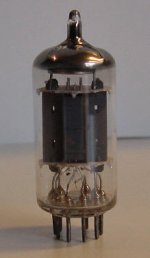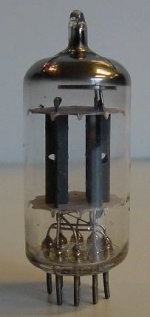Hello, I've just started with valves, all my knowledge is about transistors.
I have bought an amplifier single ended with EL84 and Don't know which valve is the driver so I posted a picture here asking if someone that really knows about this devices can recognize it. It is a 12ax7 or 12au7 or the like? The label was deleted.
Thanks in advance for your help.
I have bought an amplifier single ended with EL84 and Don't know which valve is the driver so I posted a picture here asking if someone that really knows about this devices can recognize it. It is a 12ax7 or 12au7 or the like? The label was deleted.
Thanks in advance for your help.

Attachments
It's definitely in that series, and definitely NOT a 12AT7. If you can trace out the values of the plate and cathode resistors, it would be easier to pin it down exactly.
HI SY, thanks for your prompt response
what values it is needed, voltages?, resistors?, what I need to trace exactly, I am @ work now, but I can trace tonight and inform late today or tomorrow.
Thanks again!!!!
what values it is needed, voltages?, resistors?, what I need to trace exactly, I am @ work now, but I can trace tonight and inform late today or tomorrow.
Thanks again!!!!
Some times I know if you breath on the tube, getting condensation on it will make the numbers re-appear, kindof like writing a 🙂 face on the window then breathing on it.
Welcome to the world of tubes, its like the Hotel freaking California. you can check-out anytime you like, but you can never leave! you're going to be addicted to tubes for life!
Welcome to the world of tubes, its like the Hotel freaking California. you can check-out anytime you like, but you can never leave! you're going to be addicted to tubes for life!
Hi JORGETronic,
The plates appear to make that a 12AU7, longer than a standard 12AX7 for sure. I haven't seen a so called "long plate" 12AX7 in the flesh, so I can't say for sure.
Fogging the glass is a last resort for me beyond sticking it in a circuit or tube tester.
-Chris
The plates appear to make that a 12AU7, longer than a standard 12AX7 for sure. I haven't seen a so called "long plate" 12AX7 in the flesh, so I can't say for sure.
Fogging the glass is a last resort for me beyond sticking it in a circuit or tube tester.
-Chris
Resistor values would do, voltage values would be a great confirmation.
Chris, I've got piles of old 12AX7s that look just like that. Wouldn't it be a kick if it turned out to be a 7247!
Chris, I've got piles of old 12AX7s that look just like that. Wouldn't it be a kick if it turned out to be a 7247!
Hi SY,
My 12AX7's all have short plates compared to that. 🙁 They must have shrunk!
A 7247 in a single ended amp? I'd expect to see those paired with 7591A's in push pull, but anything is possible I guess. Resistor values and voltage readings would really help at this point.
JORGETronic,
You can just list the pin numbers and resistor values that connec to the pins. That should be easy to do.
-Chris
My 12AX7's all have short plates compared to that. 🙁 They must have shrunk!
A 7247 in a single ended amp? I'd expect to see those paired with 7591A's in push pull, but anything is possible I guess. Resistor values and voltage readings would really help at this point.
JORGETronic,
You can just list the pin numbers and resistor values that connec to the pins. That should be easy to do.
-Chris
Another approach might be to describe what amplifier you have and get specs and schematic for the amp which will determine for sure what tube SHOULD be in there, even if the one you have is the wrong type that a previous owner plopped into the socket. This is usually the only way to identify a part number for a muffler bearing on a car since the numbers usually get too rusty to identify in short order. There was one exception of which I am aware where it was possible to identify a muffler bearing for a Ford Pinto by watching a particular movie. 😀
poobah said:You're being silly rca...
Gee, I thought identifying the amp by make/model and watching the movie 'Airplane' were two terrific ideas. One of 'em was even on topic! 😀
Hi Robert,
I know you are familiar with tubes a little bit. What do you think it might be from peeking at it?
-Chris
Yup! But poobah isn't used to being on topic. It makes him feel very uneasy! 😉Gee, I thought identifying the amp by make/model and watching the movie 'Airplane' were two terrific ideas. One of 'em was even on topic!
I know you are familiar with tubes a little bit. What do you think it might be from peeking at it?
-Chris
anatech said:Hi Robert,
I know you are familiar with tubes a little bit. What do you think it might be from peeking at it?
-Chris
I blew up the images and compared carefully to both 12AU7 and 12AX7's I have in stock and there is no way I can say it is one or the other. Definitely not a 12AT7 as Sy has already deduced.
It won't hurt the amp to plug in one or the other and just try it. If I had to guess I'd say it is a 12AX7 because of the application.
Well, Thanks, unfortunately the Amp is, I guess, hand made, no model number or any source of data, I will take some pictures and post here, just said: RCA CHEROKEE, has a radio included in the chassis which is dead now, the amp is working good and sound very "soft".
I will trace the pins and resistors and voltages tonight.
Jorge
I will trace the pins and resistors and voltages tonight.
Jorge
Hi, It's either a Mullard 12ax7 or 12au7. MAYBE a 7247/12dw7. If you can, please post pictures of the grid wires that you can see through the holes of the plate structure. There should be 2 of them on each side of each plate. Basically, I need to see a picture like Pic #2 but rotated about 15-20 degrees.
Thanks, Daniel
Thanks, Daniel
- Status
- Not open for further replies.
- Home
- Amplifiers
- Tubes / Valves
- new on tubes

